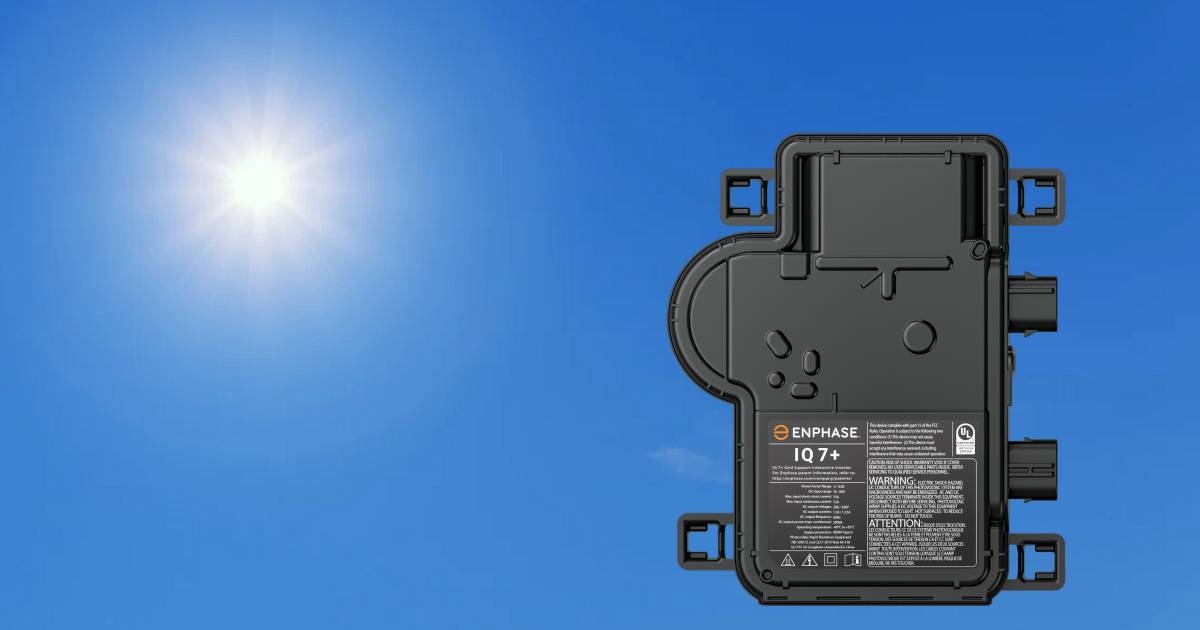
A black box of electronics sitting beneath a solar panel baking in the hot Australian summer sun. How do microinverters hold up in Australia’s scorching summers?
A little while back I received an email from someone who recently had a solar power system installed, and while researching solar inverters prior to the purchase was tossing up whether to install a single string inverter or micro-inverters.
A string inverter is the most common choice – generally one per installation, with strings of solar panels connected to it (hence the name). It’s usually installed on the wall beside a home’s switchboard/meter.
A microinverter is much smaller device and one is used per panel. It’s attached to the racking below the panel, or in the case of an AC solar panel it’s factory-integrated and takes the place of the junction box on the back of the module. Microinverters offer a number of benefits, including enhanced system design flexibility and safety, redundancy and panel level monitoring – but they add to system cost.
Anyhow, this fellow ended up opting for a single string inverter – one of his concerns being the temperature microinverters will have to endure during Sydney summers, which can get pretty toasty; particularly out west.
Some Like Tolerate It Hot
While this may not apply to all devices of this nature, Enphase microinverters are built to take the heat. The company says they can withstand up to 65°C ambient (air) temperature and 85°C internal operating temperature.
While it doesn’t reach 65°C anywhere in Australia1, temperatures in the space between the solar panel and the roof 2 can be higher than official temperature readings, which are often taken by a thermometer inside a box called a Stevenson screen. This is a ventilated wooden box that protects instruments from direct heat radiation from outside sources.
There’s also the heat generated by the microinverter itself, which plays a bigger role on internal temperature. Enphase says based on 97% efficiency, for a 5kW string inverter running at maximum capacity 150W of heat must be dissipated. For a microinverter running at 300W, only 9W of heat needs to be dissipated. Additionally, Enphase microinverters have a significant amount of surface area to dissipate heat (IQ7+ = 212 mm x 175 mm x 30.2 mm).
Enphase has evidence from the field on how its microinverters fare in extreme heat conditions. The following data is based on what the company says were the hottest days in Australian capitals last year (sourced from the Bureau of Meteorology) and the corresponding maximum internal temperature of the Enphase microinverters, which was grabbed from Enlighten servers – the company’s solar monitoring system.
| Date | Location | Max ambient temp |
Max microinverter temp |
| 4 Jan 2020 | Penrith | 48.9°C | 63°C |
| 31 Jan 2020 | Melbourne | 42.9°C | 64°C |
| 30 Jan 2020 | Adelaide | 43.9°C | 70°C |
| 4 Feb 2020 | Perth | 42.7°C | 68°C |
| 6 Dec 2020 | Brisbane | 43.5°C | 52°C |
There are some interesting/curious results in that table. For example, the highest internal temperature recorded was in Adelaide, yet the highest ambient temperature was in Penrith, Sydney by quite a margin – and what a stinker of a day that was for Penrith folks. In fact, it was claimed to be the hottest place in the world on that day.
So, what gives? The company’s explanation is hot days can be cloudy and windy. This means less power generation, better cooling, and lower internal temperatures. Enphase indicates on the hottest day at the Adelaide site, it was pretty sunny. It doesn’t mention the conditions in Penrith. And the Brisbane data looks a bit iffy – it looks like the maximum temperature on that day was 33.2°C.
That aside, it’s worth noting in none of the examples did the microinverters get even close to the maximum internal operating temperature of 85°C.
Enphase has a fair bit riding on its confidence in these microinverters being able to withstand hot days over a long period given the company offers a 10-year product warranty in Australia.

 RSS - Posts
RSS - Posts



Find the specs on each component used in the electronics with, in particular, the max temp rating.
Most normal components are rated as performing at a max of 85 deg. C. though some are rated at up to 105 deg. C .
Michael Bloch,
You state: “While it doesn’t reach 65°C anywhere in Australia[1], temperatures in the space between the solar panel and the roof [2] can be higher than official temperature readings…”
Give it time…
From phys.org news, published on 4 Oct 2017:
https://phys.org/news/2017-10-sydney-melbourne-degree-days.html
From Degrees of Risk: Can the banking system survive climate warming of 3˚C?, on page 10 (bold text my emphasis):
https://www.breakthroughonline.org.au/dor
Heat is a killer for electronic devices. The future will be hotter, so microinverters on hot roofs need to be able to endure those projected conditions now, or they likely won’t last long.
It puzzles me why the microinverters are black. Surely that is a recipe for overheating when they are exposed to the sun.
I enquired from Tindo why their panel frames are black, and received the answer “for aesthetics”. Although the panel efficiency might be compromised little by the absorbed heating, why compromise at all?
Well, they go under panels and so shouldn’t be in the sun. In the shade, black can be better for radiating heat.